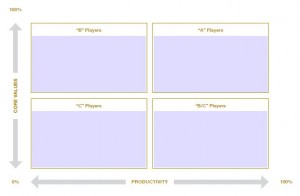Today’s news shouts that traditional performance management is “bad.”
“We’ve killed performance ratings!” and “We’ve killed the annual performance review!” are phrases being touted as if, by removing a process, the company has instantaneously changed its culture. In many cases this feels more like marketing than real change. It takes courage to change the behaviors driving the culture that may not be working for you right now.
You came to this post to hear about performance rating, and whether to kill this process or not. Continue reading to explore 5 dos and don’ts related to rating performance in a healthy, growing workplace.
1. DO rate employees’ fit with your organization’s core values and talent/performance needs as a future-focused talent assessment to support decisions that will place the right people in the right seats.

2. DON’T share with an individual how they rank against another individual. Compare an individual’s performance only against the performance (and values) the two of you mutually agreed to and have been tracking together.
3. DO take steps to create a sense of team within a diverse group of individuals. Working with the group to understand and appreciate individual talent/performance strengths can hasten the performance stage of (Tuckman’s Forming-Norming-Storming-Performing). This is possible even if their roles are distinct, such as within an accounting department where duties are purposely segregated. Start with sharing company values and short presentations that help each person understand their peers’ roles.
4. DON’T wait until a full year has passed before reviewing the performance of any individual or team. This is especially harmful when there is no means to recall performance in an objective way over the period being reviewed.
5. DO initiate performance conversations on a continuous basis. When work is stable a monthly touch-base about the 1-5 prior month accomplishments and 1-5 next month priorities works well. If the environment is dynamic, do these weekly.
People want to perform at their best. How do we assess this? We measure it. Measurement isn’t bad; it’s the human interaction—the how and when measurement happens—that goes awry.
